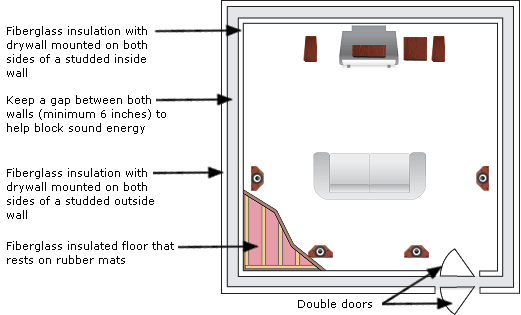Last month's Part One on home theater soundproofing received an excellent response, including rather vociferous discussion on other sites (and in emails to me), encouraging the use of a substance called “Green Glue” in place of silicone caulk. Further research indicates there is a range of various soundproofing caulks and glues available from a variety of vendors at widely varying prices. To sum up, it's the sealing properties and elasto-viscous nature of these materials that all help, but do-it-yourselfers should be cautious about some extravagant claims made for some of these materials.
Specialty Materials
One reader sent along a link to www.quietsolution.com which markets a popular specialty soundproofing drywall called QuietRock, comprised of three layers of viscoelastic, ceramic and gypsum material. QuietRock's QR-525, which incorporates these layers, claims to be remarkably effective—one 5/8-inch layer of it is said to be the equivalent of up to eight layers of standard drywall and achieve STC ratings of “up to 72”. It's certainly worth exploring these and other options.
That said, there is still no substitute for the tried and true construction techniques outlined in Part One—staggered-stud walls with double layers of drywall on each side, interior wall cavities loosely filled with sound-deadening insulation, solid-core doors (or double doors), weather-stripping, using dissimilar materials and/or air spaces and so on.
The Room Within a Room
But there is one soundproofing solution that tops them all—building a room within a room, which is derived from methods used to isolate recording studios and concert halls from all extraneous sounds and rumbles. Both the Glenn Gould studio in the Canadian Broadcasting Corporation's Toronto broadcast facility and Zankel Hall, the recital hall that is part of the Carnegie Hall complex in New York, isolated the recital halls from streetcar and subway rumbles, respectively, by constructing an interior hall that rests on huge rubber dampers. This room within a room technique not only excludes all exterior sounds but also prevents sound from within the halls themselves from escaping to other performance spaces in the buildings.

The Double Floor
You can use a similar technique by building a double floor (see illustration below) that rests on half-inch-thick rubber mats (look for these from specialty suppliers). The double floor with ¾-inch plywood on top and bottom, and fiberglass insulation between the 2 x 4 studs, supports the inner room, which also uses studded walls with drywall on both sides and sound-deadening fiberglass insulation within the wall cavities. A 6-inch air gap between the walls of the inner room and the outer room is sufficient to greatly reduce sound transmission. Carefully compute the dimensions of the inner room, taking into account the airspace between the inner and outer walls, as well as the actual thickness of the inner and outer walls, to come up with a consistent air gap of 6 inches. The dimensions of the inner room will, consequently, be much smaller than that of the outer room. The studded walls of the outer room should also use drywall on both sides.

Specialty sound-deadening insulation products are available for use within the walls and include such brands as Owens Corning QuietZone and Roxul Safe ‘n' Sound.
Since you've constructed an inner room and an outer room, it will by nature have two doors, which will be very effective in keeping sound from escaping. You should consult a specialty sound contractor for details on sound-deadening ventilation techniques that can be applied to the hot and cold air supply and return ducts as well as methods of wiring that prevent sound leaks to the outside.
It is beyond the scope of this article to go into precise carpentry techniques of floor, wall, joist, stud and header construction, but abundant material is available on the Web and in books. Here are some links to other sites and products that may prove helpful in your soundproofing endeavors:
http://www.quietsolution.com
http://www.roxul.com/sw47802.asp
http://www.owenscorning.com/quietzone/products/products.asp






